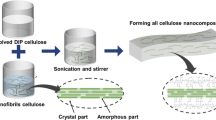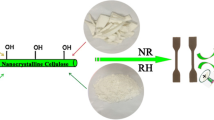Abstract
Nanocrystalline celluloses (NCCs) were isolated from different cellulose sources such as wood (softwood and hardwood), non-wood plant (cotton linters and cattail), and marine pulp (red algae) by acid hydrolysis. The NCCs were compared with respect to their dimensions, shapes, degrees of polymerization, crystallinities, thermal stabilities, and effects on the properties of bio-composites. Self-assembly phenomena of the NCCs were observed by electron microscopy. The NCCs from red algae fibers had the longest length (~432 nm) and the highest aspect ratio among the five cellulose sources. The NCCs from cotton linters, cattail fibers, and red algae fibers showed greater thermal degradation resistance than those from wood fibers. The NCCs with much lower molecular weights than their starting materials showed much higher crystalline indices than their starting ones. All-cellulose bio-composites, where the prepared NCCs were used as filaments and the dissolved cellulose as matrix, displayed increased Young’s moduli in proportion to the added amount of the NCCs.


Similar content being viewed by others
References
Azizi Samir MAS, Mateos AM, Alloin F, Alloin F, Sanchez JY, Dufresne A (2004) Plasticized nanocomposite polymer electrolytes based on poly (oxyethylene) and cellulose whiskers. Electrochim Acta 49:4667–4677. doi:10.1016/j.electacta.2004.05.021
Brinchi L, Cotana F, Fortunati E, Kenny JM (2013) Production of nanocrystalline cellulose from lignocellulosic biomass: technology and applications. Carbohydr Polym 94:154–169. doi:10.1016/j.carbpol.2013.01.033
Dos Santos RM, Flauzino Neto WP, Silvério HA, Martins DF, Dantas NO, Pasquini D (2013) Cellulose nanocrystals from pineapple leaf, a new approach for the reuse of this agro-waste. Ind Crops Prod 50:707–714. doi:10.1016/j.indcrop.2013.08.049
Dufresne A (2013) Potential of nanocellulose as a reinforcing phase for polymers. J-For: Vol.2, NO.6, 2, 6–16
Fahma F, Iwamoto S, Hori N, Iwata T, Takemura A (2010) Isolation, preparation, and characterization of nanofibers from oil palm empty-fruit-bunch (OPEFB). Cellulose 17:977–985. doi:10.1007/s10570-010-9436-4
Favier V, Chanzy H, Cavaille JY (1995) Polymer nanocomposites reinforced by cellulose whiskers. Macromolecules 28:6365–6367
Fortunati E, Luzi F, Puglia D, Dominici F, Santulli C, Kenny JM, Torre L (2014) Investigation of thermo-mechanical, chemical and degradative properties of PLA-limonene films reinforced with cellulose nanocrystals extracted from Phormium tenax leaves. Eur Polym J 56:77–91. doi:10.1016/j.eurpolymj.2014.03.030
Gaspar D, Fernandes SN, de Oliveira AG, Fernandes JG, Grey P, Pontes RV, Martins R, Godinho MH, Fortunato E (2014) Nanocrystalline cellulose applied simultaneously as the gate dielectric and the substrate in flexible field effect transistors. Nanotechnology 25:094008. doi:10.1088/0957-4484/25/9/094008
Gray DG (2013) Iridescent films from cellulose nanocrystals: chiral nematic or smectic multi-lamellar structure? J-For: Vol 3, N0 2, 3–5
Haafiz MKM, Hassan A, Zakaria Z, Inuwa IM (2013) Isolation and characterization of cellulose nanowhiskers from oil palm biomass microcrystalline cellulose. Carbohydr Polym 103:119–125. doi:10.1016/j.carbpol.2013.11.055
Habibi Y, Lucia LA, Rojas OJ (2010) Cellulose nanocrystals: chemistry, self-assembly, and applications. Chem Rev 110:3479–3500. doi:10.1021/cr900339w
Hai LV, Son HN, Seo YB (2014) Characterization of nanocrystalline cellulose from wood pulp, cotton linter, cattail and red algae fibers. 2014 Proceeding of fall conference of Korea TAPPI, Korea TAPPI, pp13-14
Helbert W, Cavaille JY, Dufresne A (1996) Thermoplastic nanocomposites filled with wheat straw cellulose whiskers. part I : processing and mechanical behavior. Polym Compos 17:4
Huber T, Müssig J, Curnow O, Pang S, Bickerton S, Staiger M (2012) A critical review of all-cellulose composites. J Mater Sci 47:1171–1186. doi:10.1007/s10853-011-5774-3
Jiang F, Hsieh Y-L (2013) Chemically and mechanically isolated nanocellulose and their self-assembled structures. Carbohydr Polym 95:32–40. doi:10.1016/j.carbpol.2013.02.022
Kalka S, Huber T, Steinberg J, Baronia K, Mussig J, Staiger MP (2014) Biodegradability of all-cellulose composite laminates. Compos Part A Appl Sci Manuf 59:37–44. doi:10.1016/j.compositesa.2013.12.012
Kim W, Lee S, Seo Y (2010) Sugar extraction by pretreatment and soda pulping from cattail (Typhaceae) (2) pulping characteristics. J Korea Tech Assoc Pulp Pap Ind 42:88–94
Lagerwall JPF, Schütz C, Salajkova M, Noh JH, Park JH, Scalia G, Bergstrom L (2014) Cellulose nanocrystal-based materials: from liquid crystal self-assembly and glass formation to multifunctional thin films. NPG Asia Mater 6:e80. doi:10.1038/am.2013.69
Lahiji RR, Reifenberger R, Raman A, Rudie A, Moon RJ (2008) Characterization of Cellulose Nanocrystal Surfaces by SPM AFM Imaging of CNCs. NSTI-nanotech 2008, www.nsti.org
Lavoine N, Desloges I, Dufresne A, Bras J (2012) Microfibrillated cellulose—its barrier properties and applications in cellulosic materials: a review. Carbohydr Polym 90:735–764. doi:10.1016/j.carbpol.2012.05.026
Majoinen J, Kontturi E, Ikkala O, Gray DG (2012) SEM imaging of chiral nematic films cast from cellulose nanocrystal suspensions. Cellulose 19:1599–1605. doi:10.1007/s10570-012-9733-1
Mccormick CL, Callais PA, Hutchinson BH (1985) Solution studies of cellulose in lithium chloride and N, N- dimethylacetamide. Macromolecules 18:2394–2401
Moon RJ, Martini A, Nairn J, Nairn J, Simonsen J, Youngblood J (2011) Cellulose nanomaterials review: structure, properties and nanocomposites. Chem Soc Rev 40:3941–3994. doi:10.1039/c0cs00108b
Morton JH (1996) Viscosity/DP relationships for cellulose dissolved in cuprammonium and cupriethylene diamine solvents. In: Kennedy JF, Phillips GO, Williams PA (eds) The chemistry and processing of wood and plant fibrous materials. Woodhead Publishing Ltd, Cambridge, pp 151–158
Neto WPF, Silvério HA, Dantas NO, Pasquini D (2013) Extraction and characterization of cellulose nanocrystals from agro-industrial residue—Soy hulls. Ind Crops Prod 42:480–488. doi:10.1016/j.indcrop.2012.06.041
Nishino T, Matsuda I, Hirao K (2004) All-cellulose composite. Macromolecules 37:7683–7687. doi:10.1021/ma049300h
Pandey JK, Chu WS, Kim CS, Lee CS, Ahn SH (2009) Bio-nano reinforcement of environmentally degradable polymer matrix by cellulose whiskers from grass. Compos Part B Eng 40:676–680. doi:10.1016/j.compositesb.2009.04.013
Peng BL, Dhar N, Liu HL, Tam KC (2011) Chemistry and applications of nanocrystalline cellulose and its derivatives: a nanotechnology perspective. Can J Chem Eng 89:1191–1206. doi:10.1002/cjce.20554
Pullawan T, Wilkinson AN, Zhang LN, Eichhorn SJ (2014) Deformation micromechanics of all-cellulose nanocomposites: comparing matrix and reinforcing components. Carbohydr Polym 100:31–39. doi:10.1016/j.carbpol.2012.12.066
Rafieian F, Shahedi M, Keramat J, Simonsen J (2014) Mechanical, thermal and barrier properties of nano-biocomposite based on gluten and carboxylated cellulose nanocrystals. Ind Crops Prod 53:282–288. doi:10.1016/j.indcrop.2013.12.016
Revol JF, Bradford H, Giasson J, Marchessault RH, Gray DG (1992) Helicoidal self-ordering of cellulose microfibrils in aqueous suspension. Int J Biol Macromol 14:170–172
Rosa MF, Medeiros ES, Malmonge JA, Gregorski KS, Wood DF, Mattoso LHC, Glenn G, Orts WJ, Imam SH (2010) Cellulose nanowhiskers from coconut husk fibers: effect of preparation conditions on their thermal and morphological behavior. Carbohydr Polym 81:83–92. doi:10.1016/j.carbpol.2010.01.059
Rueda L, Saralegui A, Fernández d’Arlas B, Zhou Q, Berglund LA, Corcuera MA, Mondragon I, Eceiza A (2013) Cellulose nanocrystals/polyurethane nanocomposites. Study from the viewpoint of microphase separated structure. Carbohydr Polym 92:751–757. doi:10.1016/j.carbpol.2012.09.093
Seo YB, Lee YW, Lee CH, You HC (2010) Red algae and their use in papermaking. Bioresour Technol 101:2549–2553. doi:10.1016/j.biortech.2009.11.088
Sim K, Ryu J, Youn HJ (2013) Effect of the number of passes through grinder on the pore characteristics of nanofibrillated cellulose mat. J Korea Tech Assoc Pulp Pap Ind 45:35–41
Sim K, Youn HJ, Ahn J, Lee J, Lee J, Jo Y (2014) Surface modification of nanofibrillated cellulose by LbL (layer-by-layer) multilayering and its effect on the dewatering ability of suspension. J Korea TAPPI 46:46–55
Siqueira G, Bras J, Follain N, Belbekhouche S, Marais S, Dufresne A (2013) Thermal and mechanical properties of bio-nanocomposites reinforced by Luffa cylindrica cellulose nanocrystals. Carbohydr Polym 91:711–717. doi:10.1016/j.carbpol.2012.08.057
Sturcová A, Davies GR, Eichhorn SJ (2005) Elastic modulus and stress-transfer properties of tunicate cellulose whiskers. Biomacromolecules 6:1055–1061. doi:10.1021/bm049291k
Acknowledgments
This research was supported from the 2010 R&D program (project number 10035477) funded by the Ministry of Trade, Industry and Energy of the Korean Government.
Author information
Authors and Affiliations
Corresponding author
Rights and permissions
About this article
Cite this article
Van Hai, L., Son, H.N. & Seo, Y.B. Physical and bio-composite properties of nanocrystalline cellulose from wood, cotton linters, cattail, and red algae. Cellulose 22, 1789–1798 (2015). https://doi.org/10.1007/s10570-015-0633-z
Received:
Accepted:
Published:
Issue Date:
DOI: https://doi.org/10.1007/s10570-015-0633-z




